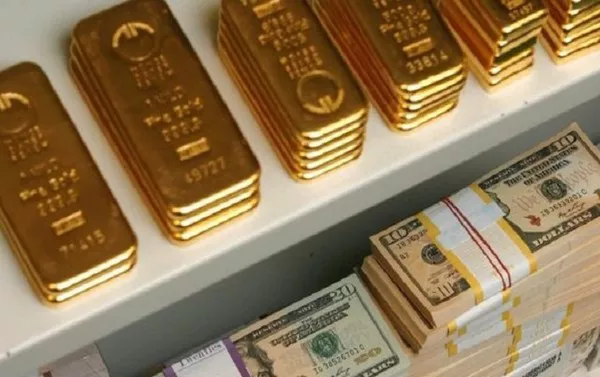In a dramatic escalation of global economic uncertainty, gold prices surged to an all-time high above $3,500 per troy ounce, driven by intensified trade tensions and a flight to safe-haven assets. The precious metal has gained approximately 30% since the start of the year, marking a milestone in a rally that began after a low in late 2022.
The rally, which saw gold first surpass $3,000/toz in March before climbing further, reflects widespread investor unease over the sweeping trade measures introduced by the Trump administration. On April 2, President Trump declared “Liberation Day,” unveiling sweeping “reciprocal” tariffs, including a blanket 10% levy on all imports into the U.S. and a sharp increase in tariffs on Chinese goods — climbing from 34% to a staggering 145%. China swiftly retaliated, raising tariffs on U.S. imports to 125%.
This escalating trade conflict has significantly disrupted financial markets, prompting a surge in demand for gold-backed exchange-traded funds (ETFs). According to the World Gold Council (WGC), ETF inflows were instrumental in driving Q1 prices, as total investment demand doubled year-on-year to 552 tons — the highest level since early 2022.
Safe-Haven Status Strengthened
Gold’s climb into record territory has been reinforced by broader fears around inflation, economic slowdown, and weakening confidence in the U.S. dollar. Bar and coin demand also jumped to 325 tons in Q1, buoyed by robust Chinese consumer buying. Central banks purchased 244 tons of gold in the same period — a slight decline from Q4 but still strong within a three-year average, according to the WGC’s “Gold Demand Trends: Q1 2025” report.
The dollar’s decline has further propelled gold demand, as trade war anxieties and rising U.S. deficits erode investor faith in traditional safe havens. “The rise in uncertainty around trade policy and international relations has been supportive of gold,” the WGC stated in its May 8 report, “A risk-induced premium that may linger.”
Adding to market instability, President Trump has publicly criticized Federal Reserve Chairman Jerome Powell, even hinting at dismissal should Powell resist cutting interest rates. Analysts warn that such actions could politicize U.S. monetary policy and damage the Fed’s credibility — further undermining the dollar and fueling a shift to gold.
Central Banks Lead Shift from Dollar Assets
Goldman Sachs and other financial institutions have highlighted a structural reallocation of reserves by global central banks — most notably the People’s Bank of China — from dollar-denominated assets toward gold. This shift gained urgency after Western sanctions froze substantial Russian foreign holdings in recent years. Fearful of similar actions, central banks are turning to gold as a hedge against geopolitical risk.
“This reflects a broader desire to diversify out of dollar assets,” said Kamakshya Trivedi, head of global FX and emerging-market strategy at Goldman Sachs. Speaking to Bloomberg, he added that central banks now see gold as the most reliable hedge amid volatile global conditions.
A Geopolitical Premium
Geopolitical instability has played a central role in gold’s ascent. James Steel, chief precious metals analyst at HSBC, told Reuters on April 8 that the current rally is unique for being driven by both geopolitical and economic fears. He contrasted today’s climate with earlier spikes tied to short-lived crises such as the Iranian Revolution. “The breakdown in international cooperation in the last few years has led to gold staying permanently high,” Steel explained.
Outlook: More Room to Run
Goldman Sachs has repeatedly revised its price forecasts upwards, now projecting $3,700/toz by year-end, with a potential surge to $3,880/toz if recession fears intensify. The bank emphasized that stronger-than-expected central bank demand and ETF inflows could push prices even higher.
J.P. Morgan echoed this bullish stance, forecasting that gold could hit $4,000/toz by mid-2026. In its April 22 report, the firm estimated Q4 2025 prices at $3,675/toz, citing recession risks linked to prolonged tariff pressures. Long-term projections are even more aggressive — J.P. Morgan recently stated that gold could reach $6,000/toz by 2029 if just 0.5% of U.S. assets held by foreign investors are redirected into gold.
“While hypothetical, this scenario illustrates why we remain structurally bullish on gold,” J.P. Morgan analysts wrote in a May 7 note. “The recent period has shown that trust in U.S. assets is no longer absolute, making gold an increasingly attractive alternative.”
Conclusion
Gold’s ascent to over $3,500 per ounce underscores its renewed status as a primary safe haven in a world rattled by trade wars, inflation, and geopolitical turmoil. With ETF inflows surging, central banks diversifying away from the dollar, and economic uncertainty looming, analysts see little standing in the way of further gains — possibly marking the dawn of a new gold era.


